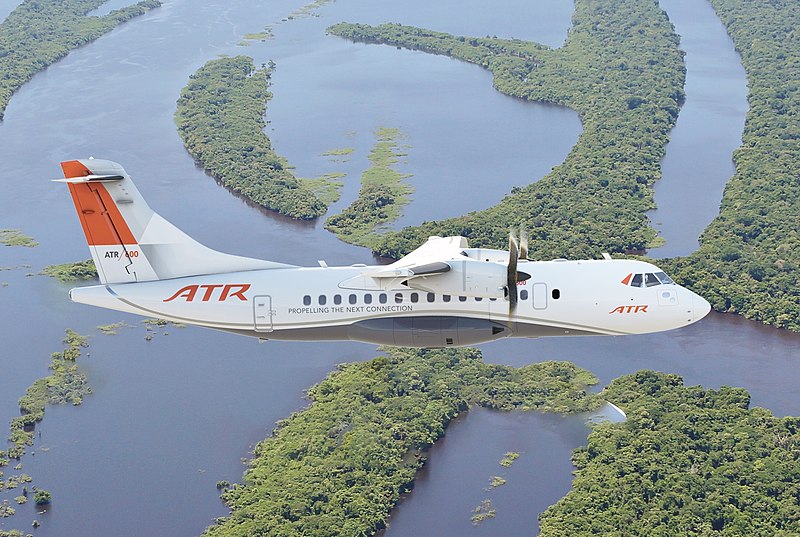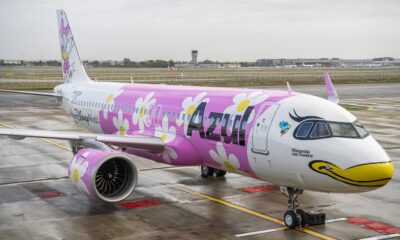Aerospace
How does the ATR-42 water crash land in comparison to the A320 and B737?
This might be the main factor in the 19 people being trapped under the aircraft. #PrecisionAir #Crash #ATR42-500

A passenger plane flight PW-494 from Tanzania crashed into Lake Victoria as it attempted to land in the lakeside town of Bukoba, killing at least 19 of its passengers. When the accident happened at roughly 08:53 local time, the ATR42-500, 5H-PWF, was en route from Dar es Salaam to Bukoba. The flight carried 39 passengers (38 Adults and 1 Infant) together with 4 crew members. The families and relatives of the passengers and crew members who were engaged in this unfortunate tragedy are offered the utmost sympathy by Precision Air.
10 things about Boeing 737 max aircraft.(Opens in a new browser tab)
The incident took place today during a flight over Mwanza from Dar es Salaam (DAR) to Bukoba (BKZ) (MWZ). On the 640-mile journey, the first flight travelled 529 miles, and the second, 111. There were 39 passengers and four crew members among the 43 people in the aeroplane (the ATR 42-500 has a capacity for 48 passengers). The airline operates about 10 ATR turboprops, including the ATR 42 and ATR 72.
Since the Precision Air ATR 42-500 crashed just a few hundred feet from land, local fishermen and rescue workers have been frantically trying to save all on board. Unluckily, 19 of the 43 passengers have been officially pronounced dead, with several of them still trapped within the plane. Tragedies like this serve as a warning that anything can go catastrophically wrong even though flying is incredibly safe. Sadly heartbreaking.
How should I proceed if an aircraft is about to crash? (Opens in a new browser tab)
How does the ATR-42 crash land in comparison to the A320 and B737?
Due to severe weather, Precision Air’s ATR 42-500 overshot the runway and ditched in the lake during the approach. However, there are various technical reasons why some of the passengers can’t escape right away. In this article, we’ll discuss how landing on an ATR 42 differs from landing on an A320 or B737.
US Airways Flight 1549
Precision Air flight plunges into Lake Victoria when landing at Bukoba Airport in Tanzania, authorities say rescue operations underway
?: Courtesy pic.twitter.com/WJLYfGeVjw
— Citizen TV Kenya (@citizentvkenya) November 6, 2022
The 19 passengers who are trapped in the aircraft may be affected significantly by this reason.
Latest Visuals of the Search and Rescue Operations of the crashed Precision Air ATR 42-500 (5H-PWE).#aircraft #safety #aviation pic.twitter.com/q8duFSg9kd
— FL360aero (@fl360aero) November 6, 2022

Aerospace
India is set to build a central command for the Air Traffic Control system, called ISHAN

India’s air traffic growth has led to increased responsibilities for air traffic control. The Airports Authority of India (AAI) is considering centralizing air traffic control for aircraft, dividing the country into four regions. The goal is to consolidate India’s segmented airspace into a single entity to improve air traffic management (ATM) efficiency, safety, and smoothness.
Recently, the AAI invited expressions of interest to develop a detailed project report for the Indian Single Sky Harmonized Air Traffic Management (ISHAN) initiative in Nagpur. Under this plan, air traffic controllers in Nagpur would handle domestic flights flying above 25,000 feet, eliminating the need for coordination among controllers in different regions.
For domestic regional flights operating above 25,000 feet, control would shift to the central command in Nagpur. This consolidation aims to enhance airline operations, increase flight handling capacity, and reduce congestion and flight times for passengers.
Currently, the AAI provides ATM services over Indian airspace and adjoining oceanic areas, covering over 2.8 million square nautical miles. This airspace is divided into four flight information regions (FIRs) in Delhi, Mumbai, Kolkata, and Chennai, along with a sub-FIR in Guwahati.
FIRs are responsible for providing air traffic services, including weather information, visibility, and search and rescue assistance. The proposed unification under the ISHAN initiative aligns with the projected growth of the aviation industry, which anticipates a doubling of domestic passenger traffic by 2030.
Aerospace
Does AirAsia show interest in Comac aircraft in the future?

Tony Fernandes, CEO of Capital A, operating as AirAsia Group, recently paid a visit to the facilities of COMAC on April 2, 2024, and was thoroughly impressed by what he witnessed.
C919 already securing nearly 1000 orders
COMAC, known for its homegrown aircraft, has launched two promising jets: the ARJ21 and the C919 aircraft. Both aircraft are gaining popularity in the Chinese market, with the C919 already securing nearly 1000 orders from various airlines.
Fernandes expressed his admiration for COMAC’s achievements in aircraft manufacturing, acknowledging the immense challenge it entails. His visit underscored the realization that AirAsia now has a viable third option when it comes to selecting aircraft for its fleet.
During his tour, Fernandes was delighted by the innovation and technology evident in COMAC’s aircraft production and the company’s commitment to long-term partnerships.
He noted that many Western companies have shifted away from prioritizing loyalty and customer service, opting instead for short-term gains and a narrow definition of success.
Last month, COMAC embarked on an international tour, showcasing demonstration flights to neighboring countries, particularly Indonesia and Malaysia. Fernandes believes that the positive impression left by COMAC during his visit opens up new opportunities for collaboration.
Fernandes emphasized COMAC’s remarkable achievements
The shared values of loyalty, customer service, and long-term vision align closely with AirAsia’s ethos, making collaboration with COMAC appealing. With a focus on innovation and excellence, both companies stand to benefit from a partnership grounded in trust and a shared commitment to success.
Indonesia and China have already collaborated in validating and maintaining the airworthiness of the ARJ21 aircraft, indicating a solid foundation for future partnerships.
In his statement, Fernandes emphasized COMAC’s remarkable achievements and genuine desire for long-term partnership, highlighting the absence of ego and a genuine willingness to succeed together. He marveled at COMAC’s fully automated, AI-driven factory, a testament to their dedication to innovation and efficiency.
Fernandes criticized Western firms for prioritizing short-term gains over loyalty, customer service, and long-term strategy, emphasizing the importance of understanding customers’ needs and collaborating to achieve success.
Aerospace
Indigo will soon launch Air Taxi Service in India

InterGlobe Enterprises, the parent brand of IndiGo, is set to revolutionize travel in India with its upcoming air taxi service.
Scheduled for a potential launch in 2026, this innovative venture promises a seamless journey for passengers between two bustling hubs. Delhi and Gurgaon in Haryana. The forthcoming service is projected to revolutionize the daily commute, offering passengers a swift aerial journey covering the distance in a mere 7 minutes.
This remarkable efficiency contrasts starkly with the conventional 90-minute drive, underscoring the immense time-saving potential for commuters. The anticipated fare, ranging from Rs 2,000-3,000, makes this innovative mode of transport not only swift but also remarkably competitive in pricing.
At the heart of this ambitious endeavor lies a strategic partnership with Archer Aviation, a pioneer in electric vertical takeoff and landing (eVTOL) aircraft technology. Under this collaboration, Archer will supply 200 state-of-the-art eVTOL aircraft, representing an investment of US$ 1 billion. These cutting-edge aircraft, capable of accommodating up to four passengers alongside the pilot, epitomize the future of sustainable air travel.
Powered by six battery packs, Archer’s eVTOL aircraft boast rapid charging capabilities, enabling a swift turnaround between flights. With a charging time of just 30-40 minutes, these eco-friendly aircraft ensure minimal downtime, maximizing operational efficiency.
Similar services are anticipated to be introduced by the joint venture in Bengaluru and Mumbai as well. Nevertheless, the service rollout period has not yet been made public by the company. Next year, it is anticipated to get its certification. Following this, the company will start the certification procedure with the Directorate General of Civil Aviation (DGCA).





























